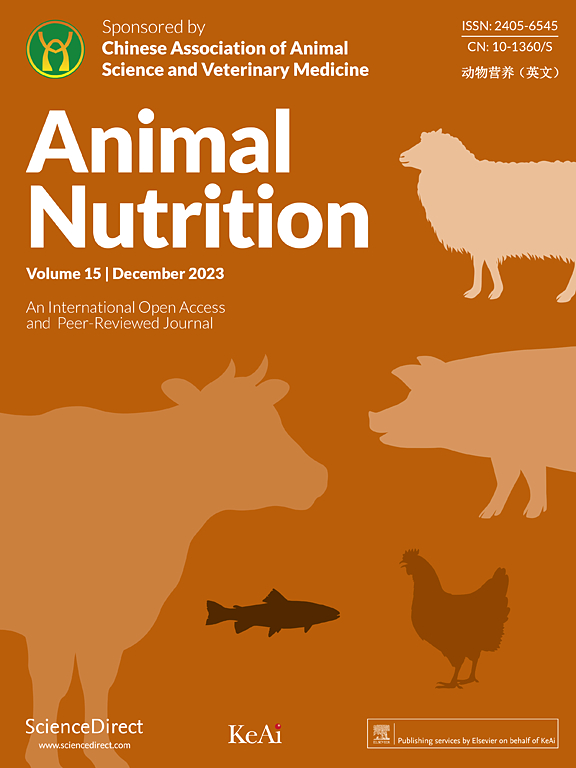Evaluation of the nutritional value of corn contaminated with deoxynivalenol and irradiated with electron beam and its effects on growth performance, nutrients digestibility, serum parameters, and intestinal permeability in piglets
IF 6.1
1区 农林科学
Q1 AGRICULTURE, DAIRY & ANIMAL SCIENCE
引用次数: 0
Abstract
Deoxynivalenol (DON) negatively affects the growth of piglets. Electron beam irradiation (EBI) has the potential to reduce the DON content in feeds. However, the quantitative effects of DON contamination and EBI on the nutritional value of corn remain unclear, as does the impact of this corn on piglet feeding. These experiments explored the effect of DON contamination and EBI treatment on the nutritional value of corn and the feeding effects of this corn on piglets. In Exp.1, 40 piglets (initial weight: 14.88 ± 1.92 kg) were allotted to five experimental diets with eight replicates per diet. Five diets included four types of corn diets: normal corn (NC), DON-contaminated corn (DON-C), EBI-treated NC (EBI-NC), and EBI-treated DON-C (EBI-DON-C), and a nitrogen-free diet formulated to determine the basal endogenous loss of amino acids. In Exp.2, 56 piglets (initial weight: 7.58 ± 0.35 kg) were randomly allocated to treatments arranged in a 2 × 2 factorial arrangement, with two types of corn (NC vs. DON-C) and two corn treatments (without EBI vs. EBI). There were four diets and seven replicate pens per diet, with two pigs per pen. The study found that both DON contamination and EBI treatment decreased the effective energy value of corn (电子束辐照脱氧雪腐镰刀菌醇污染玉米的营养价值及其对仔猪生长性能、营养物质消化率、血清参数和肠道通透性的影响
脱氧雪腐镰刀菌醇(DON)对仔猪生长有负面影响。电子束辐照(EBI)有降低饲料中DON含量的潜力。然而,DON污染和EBI对玉米营养价值的定量影响尚不清楚,这种玉米对仔猪饲养的影响也不清楚。本试验探讨了DON污染和EBI处理对玉米营养价值的影响以及玉米对仔猪的饲用效果。试验1期40头仔猪(初始体重:14.88±1.92 kg)饲喂5种试验饲粮,每种饲粮8个重复。5种饲粮包括4种类型的玉米饲粮:正常玉米(NC)、DON-C污染玉米(DON-C)、ebi处理的NC (EBI-NC)和EBI-DON-C (EBI-DON-C),以及无氮饲粮,以确定基础内源氨基酸损失。试验2中,56头仔猪(初始体重:7.58±0.35 kg)随机分为2 × 2因子处理,分别饲喂两种玉米(NC vs. dun - c)和两种玉米(无EBI vs. EBI)。试验设4种饲粮,每种饲粮7个重复栏,每个重复栏2头猪。研究发现,DON污染和EBI处理均降低了玉米的有效能值(P <;0.05), EBI处理也降低了大多数氨基酸的标准化回肠消化率(P <;DON污染对氨基酸的SID无负面影响(Exp.1)。在试验2中,EBI-C处理玉米(EBI-C)提高了平均日增重(P =0.001)和平均日采食量(P <;0.001),饲料系数(FCR)提高(P <;0.001),营养物质消化率降低(P <;0.05)。DON-C对FCR有正向影响(P = 0.005)。EBI-C和DON-C均不影响血清生化指标(P >;0.05)。然而,DON-C可能引起氧化应激,损害免疫功能,破坏肠道屏障。综上所述,EBI降低了DON- c的DON含量,影响了玉米的营养价值。此外,DON-C在一定程度上降低了仔猪的抗氧化能力和免疫功能,但对仔猪的生长性能没有影响。
本文章由计算机程序翻译,如有差异,请以英文原文为准。
求助全文
约1分钟内获得全文
求助全文
来源期刊

Animal Nutrition
Agricultural and Biological Sciences-Animal Science and Zoology
CiteScore
7.40
自引率
3.20%
发文量
172
审稿时长
12 weeks
期刊介绍:
Animal Nutrition encompasses the full gamut of animal nutritional sciences and reviews including, but not limited to, fundamental aspects of animal nutrition such as nutritional requirements, metabolic studies, body composition, energetics, immunology, neuroscience, microbiology, genetics and molecular and cell biology related to nutrition, and more applied aspects of animal nutrition, such as raw material evaluation, feed additives, nutritive value of novel ingredients and feed safety.
 求助内容:
求助内容: 应助结果提醒方式:
应助结果提醒方式:


